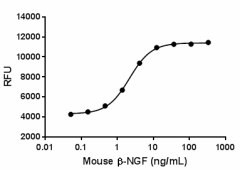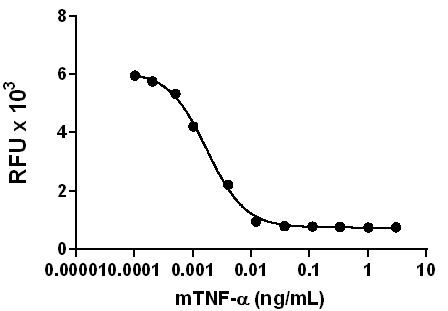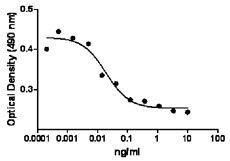- Regulatory Status
- RUO
- Other Names
- Beta-Nerve Growth Factor, HSAN5
- Ave. Rating
- Submit a Review
- Product Citations
- publications

-

Mouse β-NGF induces proliferation of TF-1 human erythroleukemic cells in a dose-dependent manner with an ED50 range of 0.4 - 4 ng/mL. -

Stability testing for Mouse β-NGF. Mouse β-NGF was aliquoted in 4 mM HCl at 0.2 mg/mL. One aliquot was frozen and thawed four times (4x Freeze/Thaw), and compared to a control kept at 4°C (Control). The samples were tested in a proliferation assay with TF-1 human erythroleukemic cells.
| Cat # | Size | Price | Quantity Check Availability | Save | ||
|---|---|---|---|---|---|---|
| 784002 | 10 µg | 54 CHF | ||||
| 784004 | 25 µg | 124 CHF | ||||
Neurotrophins are growth factors that modulate growth, differentiation, and survival of neurons. These structurally related proteins include neuron growth factor (NGF/β-NGF), brain derived neurogenic factor (BDNF), neurotrophin-3, and neurotrophin-4/5. They are highly homologous and share a similar structure of a tertiary folded, cysteine rich "knot". Neurotrophins are critical to the development of the central and peripheral nervous systems, and they play important roles in injury-induced neuron regeneration. β-NGF is a member of the neurotrophin family which controls growth, survival, and maturation of neurons. In peripheral and central neurons, neurotrophins are important regulators for survival, differentiation, and maintenance of nerve cells. They are detectable throughout embryogenesis and into the adult stage in the central and peripheral nervous systems. In animal models, β-NGF prevents neuronal degeneration and has become a therapeutic target in neuron regeneration studies. β-NGF is also critical for the survival and maintenance of sympathetic and sensory neurons. It is the main neurotrophin that maintains homeostasis of neurogenesis. It prevents neurons from undergoing apoptosis and promotes maturation while supporting axonal branching. Two receptors are known to interact with NGF, p75NTR and TrkA. The NGF-TrkA signaling pathway induces two pathways through activation of PI3K-Akt or Ras-MAPK. Both these pathways leads to CREB phosphorylation and increases expression of anti-apoptosis genes to keep neurons alive. Animal models of neurodegenerative diseases suggest that NGF can promote myelin repair of neurons in the peripheral nervous system. Clinical studies indicate that dysregulation of NGF signaling is related to Alzheimer's disease.
Product DetailsProduct Details
- Source
- Mouse β-NGF, amino acid Ser122-Gly241 (Accession # P01139) was expressed in E.coli.
- Molecular Mass
- The 120 amino acid recombinant protein has a predicted molecular mass of approximately 13.5 kD. The DTT-reduced protein migrates at approximately 14.5 kD and the non-reduced protein migrate at approximately 13.5 kD by SDS-PAGE. The predicted N-terminal amino acid is Ser.
- Purity
- >95%, as determined by Coomassie stained SDS-PAGE.
- Formulation
- 0.22 μm filtered protein solution is in 4 mM HCl
- Endotoxin Level
- Less than 0.1 EU per µg protein as determined by the LAL method.
- Concentration
- 10 and 25 µg sizes are bottled at 200 µg/mL. 100 µg size and larger sizes are lot-specific and bottled at the concentration indicated on the vial. To obtain lot-specific concentration and expiration, please enter the lot number in our Certificate of Analysis online tool.
- Storage & Handling
- Unopened vial can be stored between 2°C and 8°C for up to 2 weeks, at -20°C for up to six months, or at -70°C or colder until the expiration date. For maximum results, quick spin vial prior to opening. The protein can be aliquoted and stored at -20°C or colder. Stock solutions can also be prepared at 50 - 100 µg/mL in appropriate sterile buffer, carrier protein such as 0.2 - 1% BSA or HSA can be added when preparing the stock solution. Aliquots can be stored between 2°C and 8°C for up to one week and stored at -20°C or colder for up to 3 months. Avoid repeated freeze/thaw cycles.
- Activity
- The ED50 = 0.4 - 4 ng/mL as measured by the ability of the protein to induce proliferation of TF-1 human erythroleukemic cells.
- Application
-
Bioassay
- Application Notes
-
BioLegend carrier-free recombinant proteins provided in liquid format are shipped on blue ice. Our comparison testing data indicates that when handled and stored as recommended, the liquid format has equal or better stability and shelf-life compared to commercially available lyophilized proteins after reconstitution. Our liquid proteins are verified in-house to maintain activity after shipping on blue ice and are backed by our 100% satisfaction guarantee. If you have any concerns, contact us at tech@biolegend.com.
- Product Citations
-
Antigen Details
- Structure
- Homodimer
- Distribution
-
Broad expression including hypothalamus, pituitary, thyroid gland, testes, epididymis, vascular smooth muscle cells, fibroblasts, myofibroblasts, mast cells, eosinophils.
- Function
- Important for the development and maintenance of the sympathetic and sensory nervous systems.
- Interaction
- Neurons, astrocytes, eosinophils, B, T, and mast cells.
- Ligand/Receptor
- Low-affinity NGF receptor (p75NTR); high-affinity NGF receptor (TrkA)
- Cell Type
- Neurons
- Biology Area
- Cell Biology, Neuroscience, Synaptic Biology
- Molecular Family
- Cytokines/Chemokines, Growth Factors
- Antigen References
-
- Ullrich A, et al. 1983. Nature. 303:821.
- Klein R, et al. 1991. Cell. 65:189.
- Welker P, et al. 2000. Immunology. 99:418.
- Fahnestock M, et al. 2004. Prog. Brain Res. 146:101.
- Bruno MA and Cuello AC. 2006. Proc. Natl. Acad. Sci. USA. 103:6735.
- Aloe L, et al. 2015. Curr. Neuropharmacol. 13:294.
- Gene ID
- 18049 View all products for this Gene ID
- UniProt
- View information about beta-NGF on UniProt.org
Related FAQs
- Why choose BioLegend recombinant proteins?
-
• Each lot of product is quality-tested for bioactivity as indicated on the data sheet.
• Greater than 95% Purity or higher, tested on every lot of product.
• 100% Satisfaction Guarantee for quality performance, stability, and consistency.
• Ready-to-use liquid format saves time and reduces challenges associated with reconstitution.
• Bulk and customization available. Contact us.
• Learn more about our Recombinant Proteins. - How does the activity of your recombinant proteins compare to competitors?
-
We quality control each and every lot of recombinant protein. Not only do we check its bioactivity, but we also compare it against other commercially available recombinant proteins. We make sure each recombinant protein’s activity is at least as good as or better than the competition’s. In order to provide you with the best possible product, we ensure that our testing process is rigorous and thorough. If you’re curious and eager to make the switch to BioLegend recombinants, contact your sales representative today!
- What is the specific activity or ED50 of my recombinant protein?
-
The specific activity range of the protein is indicated on the product datasheets. Because the exact activity values on a per unit basis can largely fluctuate depending on a number of factors, including the nature of the assay, cell density, age of cells/passage number, culture media used, and end user technique, the specific activity is best defined as a range and we guarantee the specific activity of all our lots will be within the range indicated on the datasheet. Please note this only applies to recombinants labeled for use in bioassays. ELISA standard recombinant proteins are not recommended for bioassay usage as they are not tested for these applications.
- Have your recombinants been tested for stability?
-
Our testing shows that the recombinant proteins are able to withstand room temperature for a week without losing activity. In addition the recombinant proteins were also found to withstand four cycles of freeze and thaw without losing activity.
- Does specific activity of a recombinant protein vary between lots?
-
Specific activity will vary for each lot and for the type of experiment that is done to validate it, but all passed lots will have activity within the established ED50 range for the product and we guarantee that our products will have lot-to-lot consistency. Please conduct an experiment-specific validation to find the optimal ED50 for your system.
- How do you convert activity as an ED50 in ng/ml to a specific activity in Units/mg?
-
Use formula Specific activity (Units/mg) = 10^6/ ED50 (ng/mL)
 Login / Register
Login / Register 












Follow Us